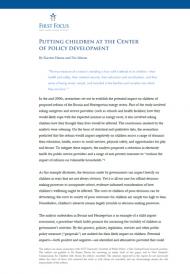 First Focus recently commissioned a policy brief on child impact assessments entitled Putting Children at the Center of Policy Development by Kirsten Hanna and Nic Mason, senior researchers with AUT University’s Institute of Public Policy, a New Zealand-based research institute. The paper highlights international efforts to implement child impact assessments and makes the case for child impact assessments here in the U.S.
First Focus recently commissioned a policy brief on child impact assessments entitled Putting Children at the Center of Policy Development by Kirsten Hanna and Nic Mason, senior researchers with AUT University’s Institute of Public Policy, a New Zealand-based research institute. The paper highlights international efforts to implement child impact assessments and makes the case for child impact assessments here in the U.S.
Child impact assessments allow for an audit of policies, legislation, services and other public policy measures to assess their likely impact on children. Potential impacts—both positive and negative—are identified and alternatives provided that could mitigate negative impacts and, where possible, maximize benefits. The process recognizes that children are entitled to be heard in decisions that affect them and that, as experts on their own lives, children’s views can enrich the information base upon which decisions are made. Hence the process improves the quality and quantity of information available to decision-makers.
The authors suggest that the child impact assessment should contain the following:
- The Proposal: A brief description of the proposal, including its rationale, aims and objectives and other relevant contextual information.
- Impacts: The likely impacts of the proposal on children (or sub-groups of children).
- Competing Interests: Any conflicts between the interests of children and other constituencies/imperatives (or between different groups of children, e.g., a gendered analysis) inherent in the proposal and its likely effects.
- Alternatives: Options for mitigating or removing negative impacts and enhancing positive impacts, with a comparison of the various options (e.g., a cost/benefit analysis or other, as appropriate).
- Justifications: When other interests are prioritized over children’s, a justification for doing so.
- Evaluation: Monitoring and evaluating the actual impact of the proposal once it is implemented against the expected impacts as well as the assessment process itself.